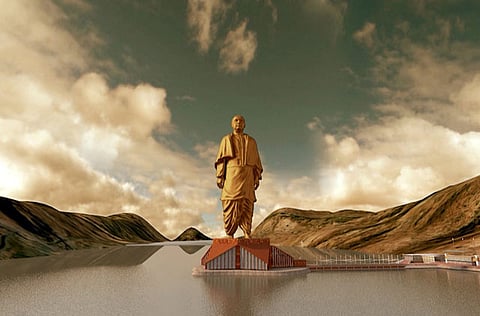India builds world’s tallest statue: Modi launches Sardar Vallabhbhai Patel tribute
Opposition leader Modi launches $338 million project in honour of Sardar Patel

New Delhi: Indian opposition leader Narendra Modi launched the construction of the world’s tallest statue on Thursday, a $338 million (Dh1.2 billion) project in honour of one of the country’s founding fathers, that he is using to undermine the ruling Nehru-Gandhi political family.
The statue of Sardar Vallabhbhai Patel, who was first Prime Minister Jawaharlal Nehru’s deputy and his interior minister, but often at odds with him, is to be built on a river island in Gujarat, the home state of both Patel and Modi.
It will be built in four years and will be twice the height of the Statue of Liberty.
“The world will be forced to look at India when this statue stands tall,” said Modi, who rules Gujarat as chief minister and is the leading opposition candidate for prime minister in general elections due by next May. His main rival in the election is the ruling Congress party’s Rahul Gandhi, Nehru’s great-grandson.
Thursday marked the 138th birth anniversary of Patel, and Modi said earlier this week: “Every Indian regrets Sardar Patel did not become the first prime minister. Had he been the first prime minister, the country’s fate and face would have been completely different.”
The comments, and the project, are seen as a not-so-subtle bid by Modi and his Hindu nationalist Bharatiya Janata Party (BJP) to appropriate an independence-era hero associated with Congress, a party largely run by the Nehru-Gandhi family.
Members of the family have ruled India for more than half the 66 years since it became an independent nation.
Nehru, his daughter, Indira Gandhi, and grandson, Rajiv Gandhi, were all prime ministers. Rajiv’s widow, Sonia Gandhi, is the current leader of the Congress and Rahul, her son, is leading the party’s campaign to take on Modi at the elections.
Opinion polls say Modi is more popular than the Gandhi scion, and he is favoured by India’s business titans for pro-investment policies and fast economic growth in Gujarat.
However, the Rs20.63 billion ($338 million) 182-metre iron and bronze statue has been widely criticised as being unnecessary in a nation where one-third of the 1.2 billion people live in poverty. It is to be financed by the Gujarat government and public donations.
“We’re turning the whole of India into a necropolis,” said Mohan Guruswamy of the Centre for Policy Alternatives, a Delhi-based think-tank.
A Gujarat government official involved in the project said it would be partially funded by small contributions, with the Gujarat government making up the difference. He denied it was a waste of funds, calling it “icon-based” development that would attract tourism.
The sub-text to the controversy is what legacy Patel left when he died in 1950, and which of India’s two main parties can legitimately lay claim to it.
Some historians have suggested Patel was more pro-Hindu than Nehru, who was fiercely secular and opposed to the 1947 partition of British-ruled India into the independent nations of Hindu majority India and Muslim Pakistan. Patel is said to have taken a more pragmatic view and is known as the builder of modern India for cajoling and coercing the country’s princely states into joining the new republic.
Despite differences with Nehru, the two worked as a team, historians have said.
“Each knew the other’s gifts, each took care not to trespass on the other person’s turf,” historian Ramachandra Guha has written.
“That is how, together, they built India anew out of the ruins of partition.”
But many in Gujarat feel Patel’s legacy has been neglected by the Congress party, and Modi has been quick to use that to his advantage. His slogan on television advertisements ahead of Patel’s birth anniversary has been: “Sardar unified the country, and we will glorify it.”
Modi’s strong association with Hindu religious politics is seen as divisive by critics. Many hold him responsible for religious riots that killed at least 1,000 people, mainly Muslims, in Gujarat in 2002, though he has denied the charges.
A Supreme Court-appointed panel did not find evidence of wrongdoing by Modi in the riots.
Several commentators have commented on the irony of Modi supporting Patel, who as home minister in 1948 helped ban the RSS (Rashtriya Swayamsevak Sangh), a Hindu organisation that Modi has close ties to, after one of its former members assassinated independence hero Mahatma Gandhi.
“Patel repudiated the RSS. But it’s equally true that Congress repudiated Sardar Patel,” said Guruswamy of the Centre for Policy Alternatives.
Sign up for the Daily Briefing
Get the latest news and updates straight to your inbox


